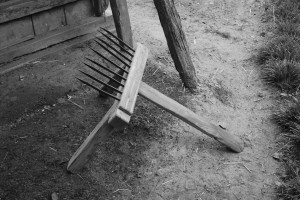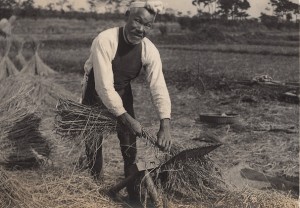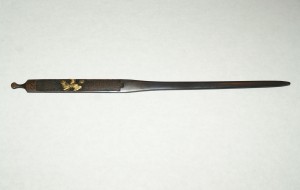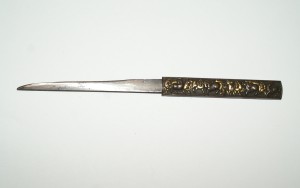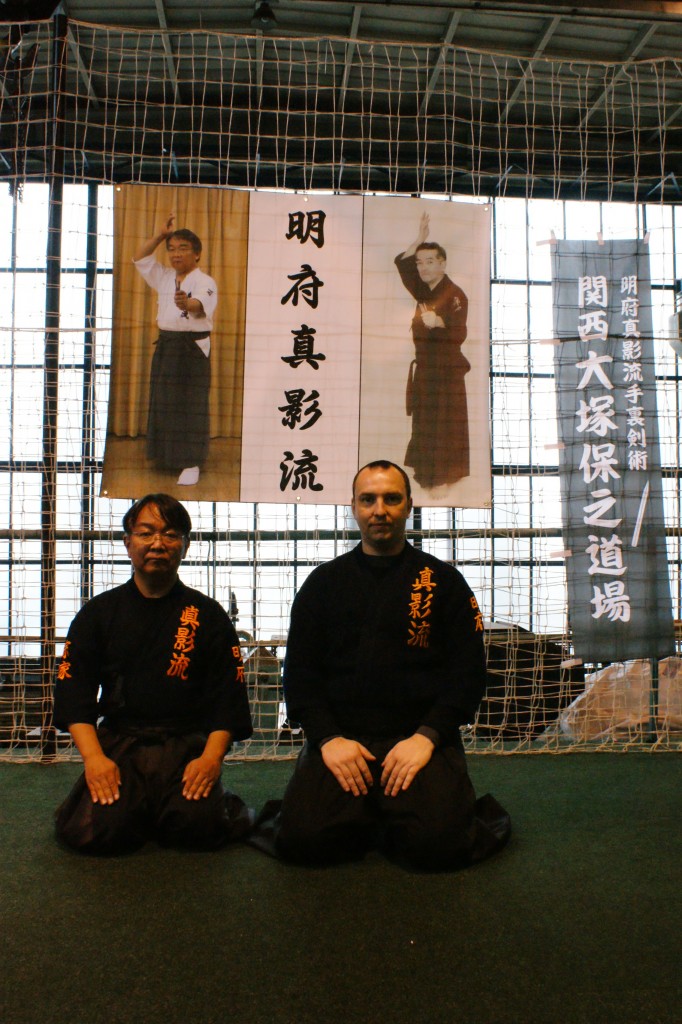Techniky Shurikenjutsu (vrhání čepelí) jsou často mylně považovány za dovednost, která byla spjatá pouze se školami Ninjutsu 忍術. Není tomu tak, tyto techniky si našly své místo i v klasických školách bojových umění prezentovaných samuraji 侍. Pojďme se podívat na to, co se vlastně skrývá za tímto termínem. Slovo Shuriken se zapisuje pomocí těchto tří znaků: 手裏剣, a dalo by se doslovně přeložit jako „ruka skrývající čepel“. Když se na to podíváme podrobněji, tak slovo Shu 手 znamená ruka. Pro přesný rozbor slova Ri 裏 je zapotřebí hlubší znalost japonštiny, ale zjednodušeně význam prezentuje myšlenku „opačný, zadní či skrytý“. V kombinaci s prvním znakem pro slovo Shu značí „skrytý v ruce či dlani“. Slovo Ken 剣 znamená čepel. Posledním termínem je slovo Jutsu 術, jehož význam je „dovednost či umění
Existují dva základní typy Shurikenů – Bo Shurikeny 棒手裏剣 a Shakeny 車剣 neboli Hira Shurikeny 平手裏剣. Bo Shurikeny jsou delší tenké čepele na konci vykované či zbroušené do špičky s různou tloušťkou a tvarem. Hira Shurikeny jsou kovové tenké pláty s různým počtem hrotů, nejčastěji ve tvaru „hvězdice“.
Škola Meifu Shinkage Ryu je zaměřena výhradně na Bo shurikeny.
Bo Shurikeny se rozdělují na několik základních tvarů. Prvním je tvar podobný dlouhé jehle, kterému se říkalo Hari Gata 針形. Druhý tvar vychází z prvního, je mu dosti podobný, ale je hranatý. Takovému Shurikenu se říkalo Kugi Gata 釘形. Dalším typem, který tady zmíním je Tanto Gata 短形. Tyto Shurikeny měly tvar velmi podobný noži. U všech uvedených typů bylo možné se setkat s mnoha tvary a s různými rozměry.
Hira Shurikeny se dělí také na několik podskupin. Typickým zástupcem základního druhu Hira Shurikenu je Senban Shuriken 銛盤手裏剣, který byl používán Shinobi 忍び školy Togakure Ryu Ninpo Taijutsu 戸隠流忍法体術. Původ Senban Shurikenu není znám, jak už to v této oblasti bývá, ale dá se předpokládat, že by se mohlo jednat o podložky, které jsou vkládány pod hřeby používané pro spojení dřevěných ploch. Další teorie tvrdí, že by se mohlo jednat o tesařskou pomůcku sloužící pro vytahování hřebů ze dřeva. Z tesařského nástroje na vytahování hřebů údajně také vycházejí Teppany 鉄板, které jsou větší verzí Senban Shurikenu, jejich šířka může být až 12 cm. Do této skupiny Shurikenů se většinou zařazují i Tsubute 礫(つぶて) což byly v podstatě kameny změněné a vytvarované ve vrhací předměty. Rád bych zde uvedl ještě Hishigane 菱金, což byly mince, které měly někdy i nabroušené okraje.
Historie Shurikenjutsu je velice dlouhá, ale zároveň je velice těžké vystopovat konkrétní data a informace o původu jednotlivých škol a tradic. Jednoduše řečeno, je velmi málo historických dokumentů, ze kterých se dá čerpat. Techniky samotné byly navíc většinou tajnou součástí učení jednotlivých škol a jako takové se nikde nezaznamenávaly, aby si tak školy udržely své know-how. Jediná dokumentace, která by mohla existovat, by nejspíše byla v rukou dané školy ve formách Densho 伝書 (svitků), jejichž obsah by byl ukazován jen nejvěrnějším studentům školy, a to až po dlouhé době studia. Daleko běžnější ale bylo, že se tyto techniky předávaly v jednotlivých školách formou Kuden 口伝 (ústní předání), což je přímá forma výuky z učitele na studenta. Další důvod, proč není tolik zmínek o této zbrani, je ten, že Shurikeny nikdy nebyly hlavní zbraní školy, ale pouze doplňkovou zbraní k mečům a dalším zbraním. Nicméně Shuriken Jutsu si postupem doby získávalo svou pozornost.
Kronika Nihon Shoki 日本書紀 (600 let n.l.) se zmiňuje o vrhání kamenů nazývaných Ishihajiki. Je ale možné, že v tomto případě bylo pro vrhání kamenů používáno praku. Dílo Kojiki 古事記, což je asi nejstarší japonská kronika, popisuje příběh, ve kterém je pasáž, kde princ Yamato vrhá jídelní hůlky do oka bílého jelena, kterého se mu takto podaří zabít. Další historické dílo Man’yoshu 万葉集 z 8. století v jedné své části popisuje vrhání šípů a na jiném místě najdeme poznámku o používání Tsubute, placatého kamene k vrhání po nepříteli. Záznamy z války Gosennen No Eki 後三年の役 (1083-87 n.l.) nesoucí název Hiyori No Ki, obsahují pasáž, která popisuje vrhání krátké čepele ukryté v dlani válečníka, Shuriken Ni Utsu (doslova: útok s čepelí v dlani). Podle některých zdrojů může být tato poznámka původem slova Shuriken.
Osaka Gunki 大阪軍記, armádní záznam Osaky, obsahuje část jež praví: „Tadamasa se uchránil před nepřítelem tím, že vytasil své Wakizashi 脇差 a vrhnul je tak, jako vrhal Shuriken“. Tvrdí se, že Tadamasa později vytvořil první Shuriken nazývaný Tanto Gata z čepele krátkého meče.
Kroniky Heike Monogatari 平家物語 a Gikeiki 義経記 zmiňují praktikování Ishi Nage 石投げ, neboli vrhání kamenů. Kameny byly speciálně tvarovány, aby se lépe házely a říkalo se jim Totekibuki 投擲武器, později již zmiňované Tsubute 礫, což znamená hodit kámen. Později byly Tsubute vyráběny z „železných kamenů“, kterým se říkalo Tetsutsubute 鉄礫, a nejspíše byly předchůdcem Senban Shurikenu.
V současnosti se můžeme setkat s mnoha rozdílnými druhy Shurikenů, což naznačuje, že vývoj umění boje s touto zbraní byl spíše nejednotný a mezi školami a oblastmi izolovaný. Podle Otsuky Yasuyuki 大塚保之 , velmistra školy Meifu Shinkage Ryu Shurikenjutsu 明府真影流手裏剣術, nebyl žádný standart nebo formát pro výrobu nebo použití Shurikenu, na rozdíl od japonského meče, což napomohlo k vytvoření různých tvarů Shurikenů jednotlivými školami. Someya Chikatoshi 親俊染谷 se pokusil vytvořit jakousi kategorizaci Shurikenů ve své knize „Shuriken Giho 手裏剣技法“, ovšem přiznal, že bez historických záznamů je taková kategorizace značně spekulativní a je mnoho příkladů, které do jeho kategorizace nesedí.
Mnohé zdroje popisující vývoj jednotlivých druhů Shurikenů jsou nezřídka velmi spekulativní. S určitostí ale můžeme uvést, že se tyto zbraně často vytvářely z nástrojů běžných v daném období. Například se tvrdí, že čepele využívané školami Chishin Ryu 知新流, Katori Shinto Ryu 香取神道流 a některými dalšími, byly vyvinuty z japonského hřebíku Wakugi 和釘, který byl ideálním materiálem pro vytvoření Bo Shurikenu určitého tvaru. Do období Meiji 明治 byly tyto hřeby hranaté a měly různou sílu a délku podle použití. Až v průběhu doby, většinou po reformách Meiji, se jejich tvar změnil na kulatý.
Když se zde zabýváme vývojem těchto zbraní, musíme uvést jednu skutečnost, a to tu, že školy zahrnující Shurikenjutsu byly velice často zaměřeny hlavně na techniky meče Kenjutsu 剣術. Některé zdroje tvrdí, že se některé Shurikeny kovaly stejným způsobem jako čepele japonských mečů. Byly tedy vyrobeny z velice pevné a tvrdé oceli. Ale podle mého názoru to bylo spíše ojedinělé. Ve většině případů byly Shurikeny vyráběny z běžně dostupného materiálu a jejich úprava nebyla zdaleka tak precizní. Důvod byl ten, že se Shurikeny většinou po odhození ztratily nebo zůstaly v oponentovi či zabodnuté v zemi. Jejich hlavním účelem bylo zpomalit protivníkův postup či odvést jeho pozornost. Pokud by byly kované a pečlivě opracovávané, stálo by jejich vytvoření mnoho času a úsilí a rozhodně by se jen tak nenechávaly zahozené po prvním použití.
Shurikeny, jejichž tvar více připomíná jehlu, jak se zdá zřejmě vycházejí z předmětů jako jsou jídelní hůlky nebo jehlice do vlasů. Otázkou je, zda čepele tohoto typu byly vytvořeny pro účely házení proti protivníkovi a nebo se přeměnily ve vrhací zbraň až časem. Některé zdroje totiž uvádějí, že se Shurikeny prvotně používaly spíše jako ruční zbraně než pro vrhání. V Togakure Ryu se také využívalo Bo Shurikenu v kombinaci se Shuko 手虎, což byla specifická zbraň pro tuto školu připomínající drápy. Zasunutí Bo Shurikenu za obruč Shuko na dlani umožnilo bojovníkovi vytvářet daleko více zničující útoky údery a seky rukou.
Otsuka Sensei (Soke Meifu Shinkage Ryu) slyšel o Bo Shurikenech, které byly vyráběny z části náčiní pro zemědělské práce a jako příklad uvádí Senbakoki 千歯扱き jako jednoho z možných předchůdců Bo Shurikenu. Senbakoki je nástroj s několika hroty, kterým se „pročesávala“ rýže či obilí. Údajně byl vyvinut někdy během období Tokugawa.
Mezi další předměty používané jako Shurikeny patří například Kogai 笄, Kozuka 小柄, Hashi 箸, Hibashi 火箸 a Hari 針. Všechno jsou to dlouhé tenké předměty tvarované jako nožíky nebo jehly používané k tradičním nebo domácím oděvům, a jsou známé díky možnosti jejich okamžitého vržení jakožto zbraně. Dalo by se říci, že byly spíš příležitostnou zbraní, neboť byly vždycky při ruce a daly se dobře házet. Až později, díky jejich dostupnosti, se tyto předměty začaly používat jako skrytá zbraň, není ovšem žádná tradiční škola, která by je výhradně používala
Kogai je v základu dlouhá špičatá kovová tyčka, u které nedokážu přesně říci, k jakému účelu původně sloužila. Ví se, že se používala jako tradiční japonská ozdobná spona do vlasů. Některé zdroje uvádějí, že se používala jako drbátko hlavy nebo jako čistič nehtů. Jisté je, že se jednalo o víceúčelový nástroj vhodný i k vrhání jakožto zbraň.
Kozuka je malý nožík, který se zasouval do boku Sayi 鞘, pochvy meče. V takto upravené Saye byl na druhé straně ještě otvor i pro Kogai, a tak mohly oba tyto nástroje tvořit součást soupravy meče.
Hashi jsou jídelní hůlky, které byly tradičně vyráběny s bambusu či jiného dřeva. Některé z nic se vyráběly z kovu, a tak se daly poté použít jako vrhací zbraně. Říká se, že zakladatel Daito Ryu Aiki Jujutsu 大東流合気柔術, Sokaku Takeda 惣角武田, u sebe nosíval vlastní sadu hůlek, které byly na jednom konci upravené do špičky a připravené změnit se kdykoli v účinnou zbraň.
Hibashi jsou kovové hůlky nebo kleště pro manipulaci se žhavým uhlím. Otsuka Sensei věří – i když to nemůže podložit důkazy – že Hibashi byly předchůdcem čepele vyvinuté školou Shirai Ryu 白井流.
Hari jsou pletací jehly, jež byly vyráběny v mnoha délkách a tloušťkách podle toho k jakému účelu sloužily. Otsuka Sensei se domnívá, že velké těžké jehly určené k sešívání kůže byly předchůdcem čepelí využívaných školou Negishi Ryu 根岸流. To by vysvětlovalo, proč má mnoho čepelí školy Negishi Ryu na svém konci kroužky nebo otvory. Je možné, že se pak do otvorů nebo kroužků navlékaly třapce nebo šňůrky, což v boji umožňovalo snazší tasení nebo přichystání zbraně.
Po reformách Meiji byly tyto dovednosti potlačovány, a tak začaly pomalu vymírat. Tomu neblaze prospělo i období po 2. světové válce. Mnoho podobných bojových umění bylo potlačeno během okupace, stejně tak jako třeba tradiční umění výroby meče. Ovšem jak se během let zvětšoval zájem a zlepšovalo se porozumění Japonsku, začalo kulturní dědictví této země přitahovat mnoho lidí ze Západu, a tak se japonské kultuře podařilo chytit druhý dech. Škola Shirai Ryu 白井流 by již dávno neexistovala, nebýt pana Saito Satoshi, který znovu oživil umění Shuriken Jutsu a zařadil jej do cvičení ve škole Negishi Ryu. Nyní studenti z celého světa navštěvují Japonsko, aby se mohli tomuto umění učit.
Zachování technik Shurikenjutsu do dnešních dnů bylo možné také díky tomu, že mnohé Koryu Bujutsu 古流武術, tradiční staré školy bojových umění, měly tyto dovednosti také zahrnuty ve své výuce. Vzhledem ke způsobu, jakým se umění předávalo, to jest od učitele k žákovi nebo od velmistra k jeho následníkovi, podařilo se tyto školy zachovat i přes ty nejtíživější a nejtěžší časy. Toto platí například pro školy Katori Shinto Ryu, Tatsumi Ryu 立身流, Yagyu Shingan Ryu 柳生心眼流, Kukishin Ryu 九鬼神流, Togakure Ryu, atd.
Dnes se zdá, že Shurikenjutsu nabývá stále větší popularity. Informace jsou dnes daleko snadněji dostupné než tomu bylo dříve, a tak se Umění Shurikenů vyučuje i v mnoha Dojo 道場 bojových umění, které nemají přímou historickou vazbu k Shuriken Jutsu. Například v Dojo Iwama Aikido 岩間合気道 v prefektuře Ibaraki 茨城 mají studenti veliký zájem naučit se dovednosti Shuriken Jutsu, které tak dobře ovládal jejich učitel Morihito Saito 斉藤守弘.
Přístup k tomuto umění, byl donedávna dost omezený, studenti museli podepsat přísahu odpovědnosti a ještě k tomu získat povolení od samotného velmistra, který posoudil, zda se mohou umění učit.
Později, kdy se kov stal mnohem dostupnějším, jak díky importu, tak díky zlepšení ve zpracovávání rudy, se Shurikeny začaly vyrábět účelově, zejména ve školách, které měly tradici v jejich používání. Všechna Dojo nebo rodiny měly většinou svého kováře, kterému řekly o ukování čepelí, když bylo třeba. Většina Sogo Bujutsu, neboli bojová umění, která obsahují více disciplín a zabývají se i technikami Shurikenjutsu, jako třeba Yagyu Shingan Ryu, Katori Shinto Ryu atd., přebírala zpočátku všechny inovativní nápady jedinců do svého učení. Dovednostem se začala dávat forma, aby se dali daly lépe trénovat, předávat a uchovat pro další generace studentů. Jakmile se uchytila tradice předávání forem v dané škole, přijal se i jakýsi základní tvar čepele a díky tomu má každá škola pro sebe typický tvar Shurikenu, který se později začal dělat na míru pro danou školu. Je stále mnoho učitelů tradičních bojových umění, kteří nadále vyučují zacházení s Shurikeny a pokračují v jejich vývoji. Příkladem takového člověka je Soke 宗家 (velmistr) školy Meifu Shinkage Ryu, pan Yasuyuki Otsuka. Otsuka Sensei převzal učení svého učitele Someyi Senseie vyučujícího Katori Shinto Ryu. Someya Sensei byl osobou nanejvýše fundovanou v oblasti Shuriken Jutsu. Své znalosti kromě jiného také sepsal ve své knize Shuriken Giho. Své znalosti starých forem Shuriken Jutsu propracovával do největších detailů a některé z nich upravil pro dnešní chápání vrhacích zbraní. Otsuka Sensei studoval několik let po boku Someyi Senseie a pokračuje dál v hlubokém studiu těchto dovedností a vývoji jejich technik. Otsuka Sensei se také zná s některými velmi zručnými kováři, kteří mu vyrábějí kvalitní čepele pro trénink technik v jeho škole. Je ovšem také spousta škol, které pokračují ve striktní výuce, aby mohly dál předávat svou tradici a bezpochyby své čepele získávají stejným způsobem.
Tradice pokračuje dál…

